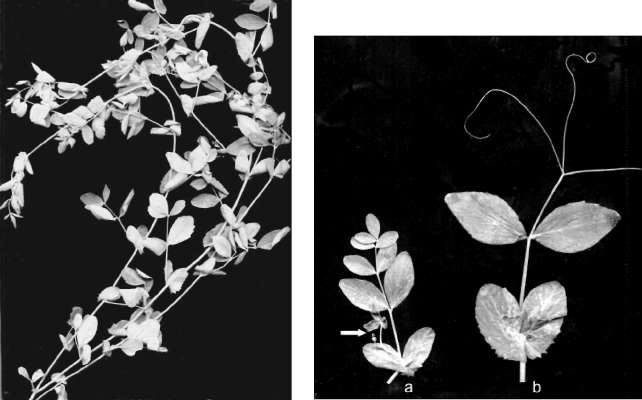Pisum Genetics
2006—Volume 38
Research Papers
A new allele at the Tl locus — tl na
Rozov, S.M.
Inst. of Cytol. and Genet. Siberian Branch of Russ. Acad. of Sci., Novosibirsk, Russia
A mutant line SGE-0812 with a clavicula (1, 2) (tendrilless) phenotype was isolated from the M2 progeny of EMS-treated pea line SGE. In addition to the classical acacia-like leaf appearance, line SGE-0812 carries some other striking features. The whole plant of SGE-0812 is one-half to one-third the size of the SGE parental line. All parts and organs of plant are diminished proportionally. We denote this phenotype as nana. In addition, the SGE-0812 line has a strong ramosus tendency, forming lateral branches of different length at almost every node (figs. 1 and 2). It should be noted that the plants of the parental line SGE have only the main stem and very rarely form short lateral branches.

Fig. 1. SGE-0812 mutant line. This plant has two well developed lateral branches and many short lateral branches, while the parental SGE line usually forms only a single main stem.
Fig. 2. Leaf of the SGE-0812 mutant (a) and the parental line SGE (b). Arrow indicates a lateral branch typical of the mutant line but rarely observed in the SGE parent.
Allelism test in the cross of SGE-0812 with the tester line WL1238 carrying the clavicula gene tlw revealed that all F1 progeny had an obvious tl (clavicula) phenotype. Thus, the SGE-0812 mutant evidently carries a new allele of the well-known tl gene. There remained the question whether the other phenotypic features of SGE-0812, such as size reduction (nana) and abundant branching (ramosus) result from an activity of the new tl allele or are independent mutation events. To clarify this uncertainty, I crossed the SGE-0812 line with the parental SGE line. In this cross all F1 plants were of normal length, typical of the SGE line. The hybrid plants
15